Sep 12, 2017 | Science and Art, Systems Analysis
By Gerid Hager, IIASA Ecosystems Services and Management Program
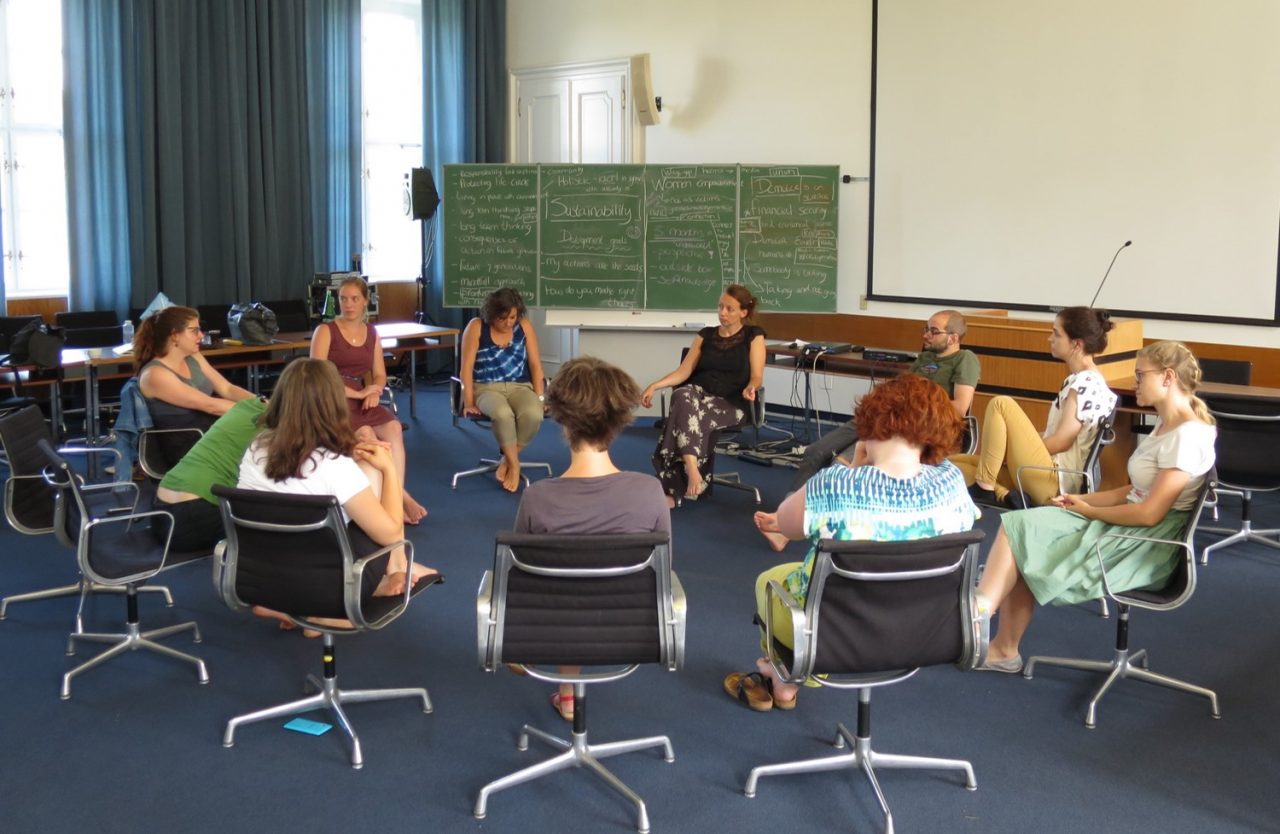
©Gerid Hager | IIASA
In July, Miranda Lakerveld, a music drama artist and founder of the World Opera Lab, visited IIASA to run two storytelling workshops with young actors in civil society and youth policy, as well as with YSSP students and IIASA staff. Miranda first came to IIASA in September 2016 as part of the Citizen Artist Incubator.
After the workshops in July, Miranda and I sat down for a chat.
Gerid: Miranda, in the workshop you shared how you approach storytelling in your artistic practice. You said: “I’m looking for moments that feel true, I pick them up and weave them together into new stories.” Then, a participant exclaimed: “Stories are not true!” It seems a contradiction, but possibly this is the very nature of stories. They might not be true, giving accurate accounts of past events, but they carry truths in them, which we so often can’t capture otherwise. You’ve been working with myths for a long time: What value do you see in them today, as we’re trying to navigate between “alternative facts” and often incomprehensible scientific writing?
Miranda: Yes, this was a short reflection on the methodology I have developed and applied in many different contexts over the last eight years. It uses comparative mythology as a starting point. The aim of the method is to create a meaningful creative exchange that can involve people from all walks of life. Myths are examined from the perspectives of different cultures, and through this intercultural lens, we find symbols and archetypes that resonate as ‘true’ across cultures.
The ‘post-truth’ era made us extra aware of the divides between communities and I believe such an embodied practice of mythology can be an inspiring place for people to meet. I think the renunciation of facts and scientific insight is a symptom of people feeling left out and angry. Using myths and stories can be one way to bring people together and find common truths.
This workshop was part of the Systems Thinking for Transformation project and we wanted to search for “systems stories” in ancient narratives. We arrived at a very personal story of endurance and adaptation, pondered the power of great nature and cyclical behavior on a very large scale, and discussed economic justice and its relation to sustainable development. How does one story from Greek mythology – the Hymn to Demeter – lead to such diverse considerations?
The development of myths and folk stories has very specific characteristics, which I like to compare to ecosystems. Symbols and characters create organisms in constant interaction with their environments. Through time, myths change, in fertile circumstances the stories flourish, and layers of meaning are added.
Participants relate the Greek myth to myths from their own cultural backgrounds, and then to their personal histories. Interestingly, in the encounter between the myth and a group, some deeply felt preoccupations spring up from under the surface. I am still not sure how this happens. It probably has to do with a combination of embodiment of the characters, the richness of the archetypes, and the mise en scène, which represents the people inside the larger system.

Majnun & Leyla- World Opera Lab 2016- photo by Fouad Lakbir
One integral part of systems thinking is to be able to consider and explore multiple perspectives on a problem or situation. How does the embodiment exercise come in to this?
Slipping into different characters from the story is an essential part of the process. It unlocks the creative imagination and is related to action in society. The Greek root-word for drama is “dran”, which means “to act”. Through embodiment we can take the position of another character or force in the system. The performing arts make this possible: we can take on different roles, understand new parts, and at the same time experience the whole system from a new perspective.
There are other examples of how art and science meet through storytelling. A researcher at Berkeley University teamed up with story artists from PIXAR to help researchers create better stories about their research. What interests you in working with scientists and what is the role of storytelling?
I think the collaboration between art and science could go far beyond creating stories about research. We see very different approaches of creating and transmitting knowledge. So we have to deal with this tension but an inclusive society also means we should value these differences. The academic world has created an intricate system of validating knowledge leading to very specialized fields of research. Artists work on larger ideas, but the output cannot necessarily be validated. We are trying to grasp truths about the same river, but we work from opposite river banks. I think we can build bridges and increase our ability for insight and action by telling stories together.
This article gives the views of the author, and not the position of the Nexus blog, nor of the International Institute for Applied Systems Analysis.
Aug 30, 2017 | Environment, Food & Water, Young Scientists
By Parul Tewari, IIASA Science Communication Fellow 2017
Two things are distinctly noticeable when you meet Cornelius Hirsch—a cheerful smile that rarely leaves his face and the spark in his eyes as he talks about issues close to his heart. The range is quite broad though—from politics and economics to electronic music.

Cornelius Hirsch
After finishing high school, Hirsch decided to travel and explore the world. This paid off quite well. It was during his travels, encompassing Hong Kong, New Zealand, and California, that Hirsch started taking a keen interest in economic and political systems. This sparked his curiosity and helped him decide that he wanted to take up economics for higher studies. Therefore, after completing his masters in agricultural economics, Hirsch applied for a position as a research associate at the Austrian Institute of Economic Research and enrolled in the PhD-program of the Vienna University of Economics and Business to study trade, globalization, and its impact on rural areas. Currently, he is looking at subsidies and tariffs for farmers and the agricultural sector at a global scale.
As part of the 2017 Young Scientists Summer Program at IIASA, Hirsch is digging a little deeper to analyze how foreign direct investments (FDI) in agricultural land operate. “Since 2000, the number of foreign land acquisitions have been growing—governmental or private players buy a lot of land in different countries to produce crops. I was interested in knowing why there are so many of these hotspots in the world— sub-Saharan Africa, Papua New Guinea, Indonesia—why are people investing in these areas?,” says Hirsch.
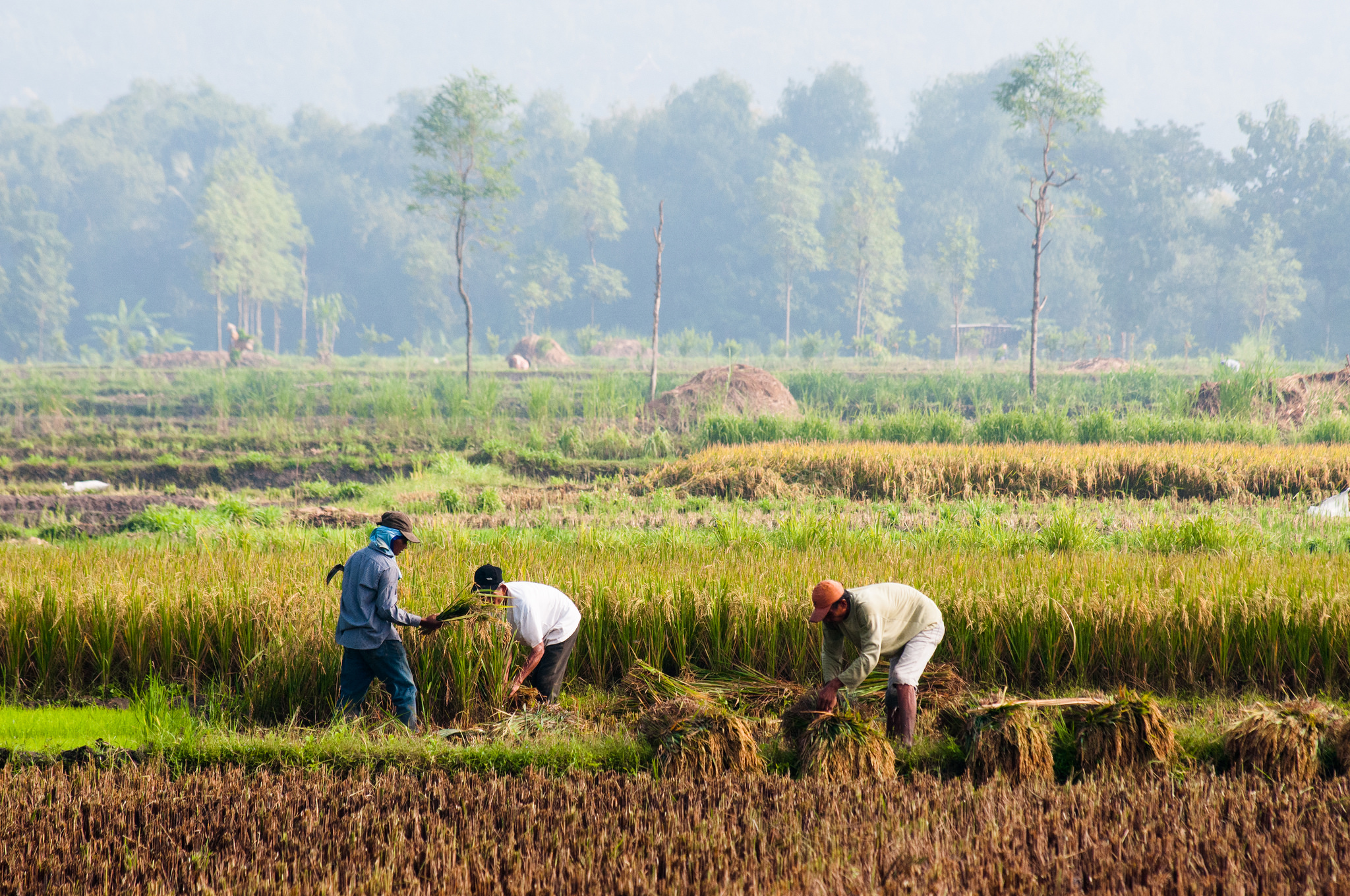
Farming in one of the large agricultural areas in Indonesia ©CIFOR I Flickr
Increased food demand from a growing world population is leading to an increased rate of investment in agriculture in regions with large stretches of fertile land. That these regions are largely rain-fed make them even more attractive for investors as they save the cost of expensive irrigation services. In fact, Hirsch argues that “the term land-grabbing is misleading. It should actually be water-grabbing as water is the foremost deciding factor—even more important than simply land abundance.”
Some researchers have found an interesting contrast between FDI in traditional sectors, such as manufacturing, and the ones in agricultural land. While investors in the former look for stable institutions and good governmental efficiency, FDI in land deals seems to target regions with less stable institutions. This positive relationship between corruption and FDI is completely counterintuitive. Hirsch says that one reason could be that “sometimes weaker institutions are easier to get through when it comes to such vast amount of lands. A lot of times these deals and contracts are oral and have no written proof—the contracts are not transparent anyway.”
For example in South Sudan, the land and soil conditions seem to be so good that investors aren’t deterred despite conflicts due to corrupt practices or inefficient government agencies.

One of the indigenous communities in Madagascar, a place which is vulnerable to land acquisitions © IamNotUnique I Flickr
One area that often goes unnoticed is the violation of land rights of indigenous communities. If a government body decides to sell land or give out production licenses to investors for leasing the land without consulting the actual community, it is only much later that the affected community finds out that their land has been given away. Left with no land and hence no source of livelihood, these communities are forced to migrate to urban areas.
A strain of concern enters his voice as Hirsch talks about the impact. “Land as big as two times the area of Ecuador has been sold off in the past—but it accounts for a tiny percentage of the global production area.” With rising incomes and greater consumption of meat, a lot of land is used to produce animal feed crops. “This is a very inefficient way of using land,” he says.
During the summer program at IIASA, Hirsch is generating data that will help him look at these deals in detail and analyze the main factors that are taken into consideration before finalizing a land deal. At the moment he is only able to give an overview of land-grabbing at the global level. With more data on the location of the deals he can look at the factors that influence these decisions in the first place such as the proximity between the two countries involved in agricultural investments and the size of their economies.
While there is always huge media coverage when a scandal about these land acquisitions comes out in the open, Hirsch seems determined to dig deeper and uncover the dynamics involved.
About the researcher
Cornelius Hirsch is a research associate at the Austrian Institute of Economics and Research (WIFO). At IIASA he is working under the supervision of Tamas Krisztin and Linda See in the Ecosystems Services and Management Program (ESM).
This article gives the views of the author, and not the position of the Nexus blog, nor of the International Institute for Applied Systems Analysis.
May 9, 2017 | Alumni, Young Scientists
Former IIASA Director Roger Levien started the Young Scientists Summer Program (YSSP) in the summer of 1977. After 40 years the program remains one of the institute’s most successful initiatives.
The idea for the YSSP came out of your own experience as a summer student at The RAND Corporation during your graduate studies. How did that experience inspire you to start the YSSP?
At RAND I was introduced to systems analysis and to working with colleagues from many different disciplines: mathematics, computer science, foreign policy, and economics. After that summer, I changed from a Master’s in Operations Research to a PhD program in Applied Mathematics and moved from MIT to Harvard, because I knew that I needed a broad doctorate to be a RAND systems analyst.
From that point on, I carried the knowledge that a summer experience at a ripe time in one’s life, as one is choosing their post university career, can be life transforming. It certainly was for me.

Roger Levien, left, with the first IIASA director Howard Raiffa, right. ©IIASA Archives
Why did you think IIASA would be a good place for such a summer program?
When I thought about such a program within the context of IIASA, it seemed to me that it would offer an even richer experience than mine at RAND. I thought, wouldn’t it be wonderful to bring young scientists from many nations together in their graduate-program years at IIASA. At that time, systems analysis was not well-known anywhere outside of the United States, and even there it was not very well known. In universities interdisciplinary research, and especially applied policy research, was almost nonexistent.
This would be an opportunity to introduce systems analysis to graduate students from around the world, who were otherwise deeply involved in a single discipline. It would be fruitful to bring them together to learn about the uses of scientific analysis to address policy issues, and about working both across disciplines and across nationalities.
What was your vision for the program?
I hoped that these students, who had been introduced to systems analysis at IIASA, would become an international network of analysts sharing a common understanding of international policy problems. And in the future, at international negotiations on issues of public policy, sitting behind the diplomats around the table would be technical experts, many of whom had been graduate students at IIASA, having worked on the same issue in a non-political international and interdisciplinary setting. At IIASA they would have developed a common language, a common way of thought, and perhaps working together at the negotiation they could use their shared view to help their seniors achieve success. A pipe dream perhaps, but also an ideal and a vision of what people from different countries and different disciplines who had studied the same problem with an international system analysis approach could accomplish.

Social activities have been an important component of the YSSP since the beginning ©IIASA Archives
The program is celebrating its 40th year. Why do you think it has been so successful?
I think there are many reasons for success. But for one thing, it’s my impression that just having 50 enthusiastic young scientists around brings an infusion of energy, which is a great boost to the institute. The young scientists also bring findings and methods on the cutting edges of their disciplines to IIASA.
What would be your advice to young scientists coming this summer for the 2017 program
It would be to engage as deeply as you can and as broadly as you can. This is an opportunity to learn about many things that aren’t on the curriculum of any university program. So, now’s the time to engage not only with other disciplines, but with people from other nations, to get their perspective. The people you meet this summer can be lifelong contacts. They can be your friends for life, your colleagues for life, and the opportunities that will open through them, though unpredictable, are bound to be invaluable, both professionally and personally.
This is a learning experience of an entirely different type from the typical graduate program, which goes deeper and deeper into a single discipline. You have a unique opportunity to go broader and wider, culturally, intellectually, and internationally.
IIASA will be celebrating the YSSP 40th Anniversary with an event for alumni on June 20-21, 2017.
This article gives the views of the interviewee, and not the position of the Nexus blog, nor of the International Institute for Applied Systems Analysis.
Mar 31, 2016 | Systems Analysis
By Melina Kourantidou, MSA 2015 participant, PhD student, Department of Environmental and Business Economics, University of Southern Denmark
In summer 2015 I participated in the Summer Academy on Economic Growth and Governance of Natural Resources in Lomonosov Moscow State University. I was inspired by the interdisciplinary lectures there as well as by recent developments in Arctic marine governance to propose a game-theoretical model for Arctic fisheries management.
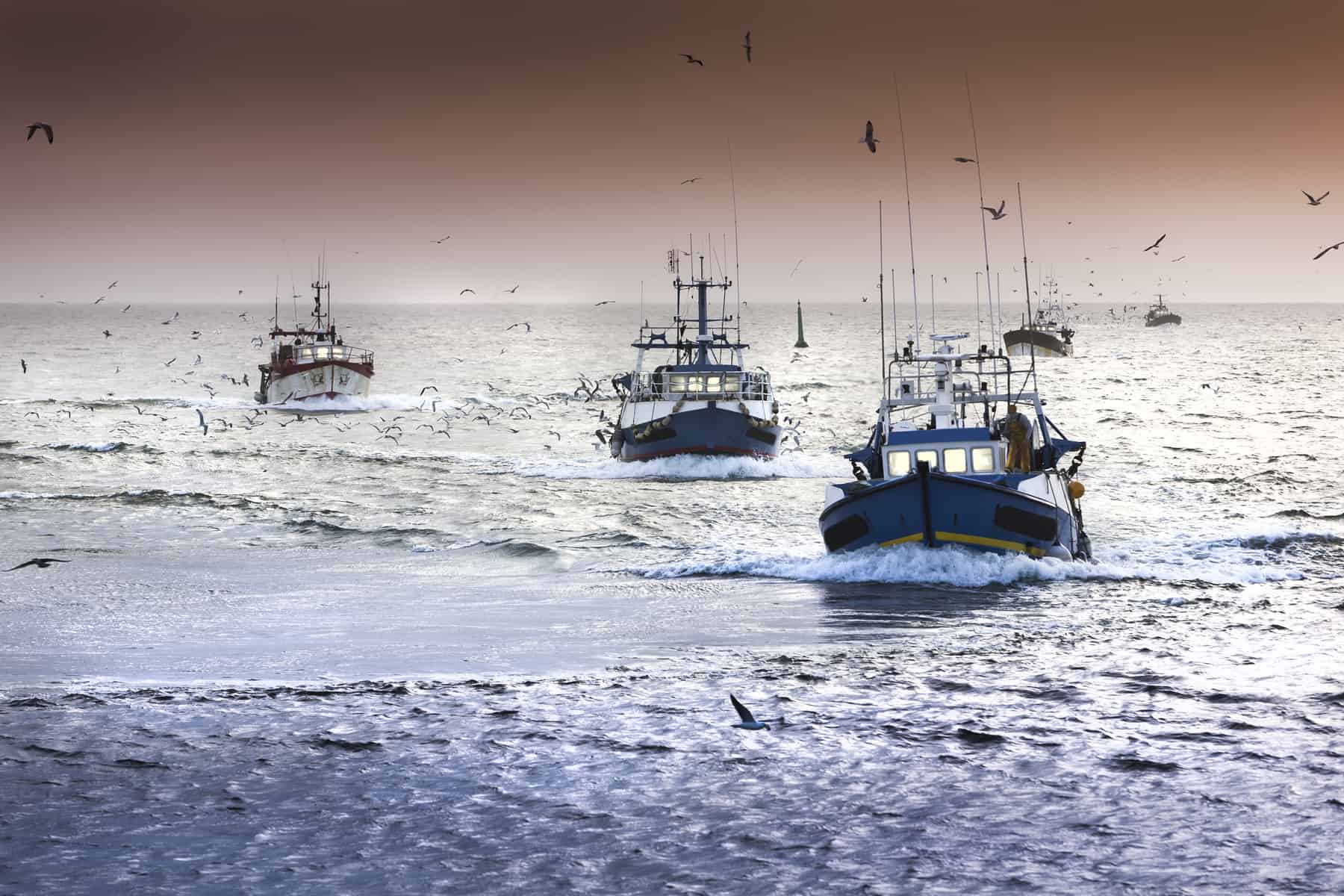
While commercial fishing in the central Arctic Ocean is unlikely to become common anytime soon, fisheries management in the region includes complex decision making challenges. © Fernbach Antal – Fotolia | Dollar Photo Club
In July 2015, representatives from the five Arctic Ocean coastal states (Canada, Denmark, Norway, Russia and the United States) signed the Declaration Concerning the Prevention of Unregulated High Seas Fishing in the Central Arctic Ocean. In the declaration text it is clearly stated that “commercial fishing in the high seas portion of the central Arctic Ocean is unlikely to occur in the near future.” This approach increases the stature of the Precautionary Principle, a strategy that copes with possible risks in cases where scientific information is limited. The declaration is the first official attempt to regulate international waters of the Central Arctic Basin. While commercial fishing in the central Arctic Ocean is unlikely to become common anytime soon, fisheries management in the region includes complex decision making challenges, while it is also complicated by multiple factors, including transboundary fish stocks—those crossing boundaries of Exclusive Economic Zones (EEZs) — and straddling stocks (those typically found in the high seas adjacent to the EEZ) arising from the unsettled maritime boundary lines, thus often calling for the establishment of an effective bilateral or multilateral regime.
The contentious and divisive issue of how to handle Arctic fisheries has mostly been discussed so far in literature from a biodiversity standpoint rather than an economic one. Yet looking at the problem from an economic standpoint could help provide information that could prevent optimal use of resources and thus contribute to preventing irrational behaviors that may lead to the collapse or disruption of the ecosystem. Optimization theory provides critical insights for individual fishers or countries pursuing the most profitable strategy (higher payoffs). At the same time it can also prove useful for broader decision-making processes whereby all interested parties cooperate on the management of Central Arctic fish stocks.
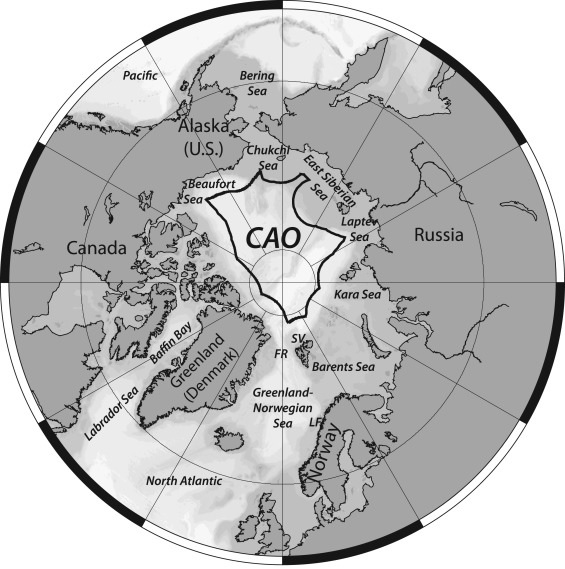
A map of the Central Arctic Ocean shows the many countries that border the ocean. © Shephard et al., 2016
Game theory can potentially contribute in a more complex setting, with two or more actors—states in our case—involved in fishing resource management and with each state being able to choose among a set of available options, with their payoff dependent on other states’ choices.
There are a number of different types of games available in the game theoretical framework. Given the existing risks and uncertainties over Arctic marine resources I would propose a differential game setting as a baseline scenario. A differential game is a mathematical formulation used for either conflict or cooperation where players’ strategies are changing over time.
A differential game seems suitable since there is an underlying assumption that the “Arctic players” involved make decisions at all time points and not necessarily in specific time intervals. Furthermore a repeated static game (players deciding simultaneously with no prior knowledge of other players’ choices), such as the Prisoner’s Dilemma, would probably not work as well here, since the payoff functions of our players would not be time-dependent.
If we are looking for a solution where all involved Arctic states agree to cooperate on the management of marine resources in the Central Arctic, we would probably need to solve it as a standard optimal control problem, through the use of maximum principle or dynamic programming. In other words the outcome of optimizing a joint welfare function should be examined regarding its efficiency, which brings together the different Arctic players in a joint effort to maximize their average individual welfare.
Another theory known as Nash equilibrium could provide useful insights with regard to incentives and motivations, especially in cases, like the one described here, where it is rather daunting to predict how different players will behave in a game. A Nash equilibrium comes down to a set of different strategies for each one of the players included in the game, indicating that neither player has incentive to change their choice (taking others’ choices as given) since their payoffs are not improving anyway.
An open-loop solution that gives Nash equilibrium would result in all players having absolutely no incentive to deviate from their specific strategic path, given the path of other players or in other words having the players at a Nash Equilibrium would make them unwilling to act differently, since they would be worse off if they did.
An Open Loop Nash Equilibrium can be examined where there is exclusive dependence on the time variable; if a player deviates from the equilibrium control, even if briefly, and decides to return to its former behavior, the equilibrium is broken. Conversely, in a feedback (or closed-loop) Nash Equilibrium which is strongly time consistent, the dependence lies on the current state of the system. Differential games can generally help towards answering whether a potential cooperative solution can be achieved through a Nash equilibrium of a non-cooperative game.
Yet another question is whether countries would prefer to cooperate instead of competing for fishing in the Central Arctic. A cooperative scenario would require a Net Present Value (sum of benefits minus sum of costs, both in present values) larger than the non-cooperative scenario, thus covering the opportunity costs arising from the cooperative case. If this condition is not satisfied we will have to accept that there will be a non-cooperative behavior up to the point that cooperation turns lucrative for all players.
Game theoretic approaches with regard to stock management have provided useful insights and directed new lines of inquiry, but the dynamically changing Arctic raises issues that call for coordinated responses, for example through the use of more robust tools such as evolutionary game theory. Given that many species are expected to expand to yet unexploited parts of Arctic waters, one major concern is the consequences of coastal states’ harvesting activities on society’s wellbeing, and the ways in which it will be made possible to leave a positive legacy for future generations.
Looking at the interplay of ecology and economic behavior is one way that scientists can begin to answer these questions. Meticulous research on strategies of defection, cooperation and enforcement can be a cornerstone for establishing and managing effective ways to protect the Arctic marine environment, taking into account the current dearth of research in existing and future biodiversity.
Read my full report on the MSA 2015 Web site (PDF)
Note: This article gives the views of the author, and not the position of the Nexus blog, nor of the International Institute for Applied Systems Analysis.
Mar 22, 2016 | Water
By Taher Kahil, IIASA Water Program
This year’s theme of the UN World Water Day is “Water and Jobs.” It focuses on how adequate water management can change workers’ lives. Indeed, water management and job creation are tightly linked. Nearly all jobs depend on water, and without reliable and safe access to water, neither small activities nor major global industries can endure. Similarly, labor is necessary to build, maintain, operate, and manage the water system, and to run water-based projects. Furthermore, job creation can be a thirsty business in both developing and developed countries. In many developing countries irrigation projects, requiring significant amounts of water, are considered the main engine for the economy and source of employment. In developed countries, less water is needed but it still requires sufficient quality for manufacturing and service projects creating job opportunities.
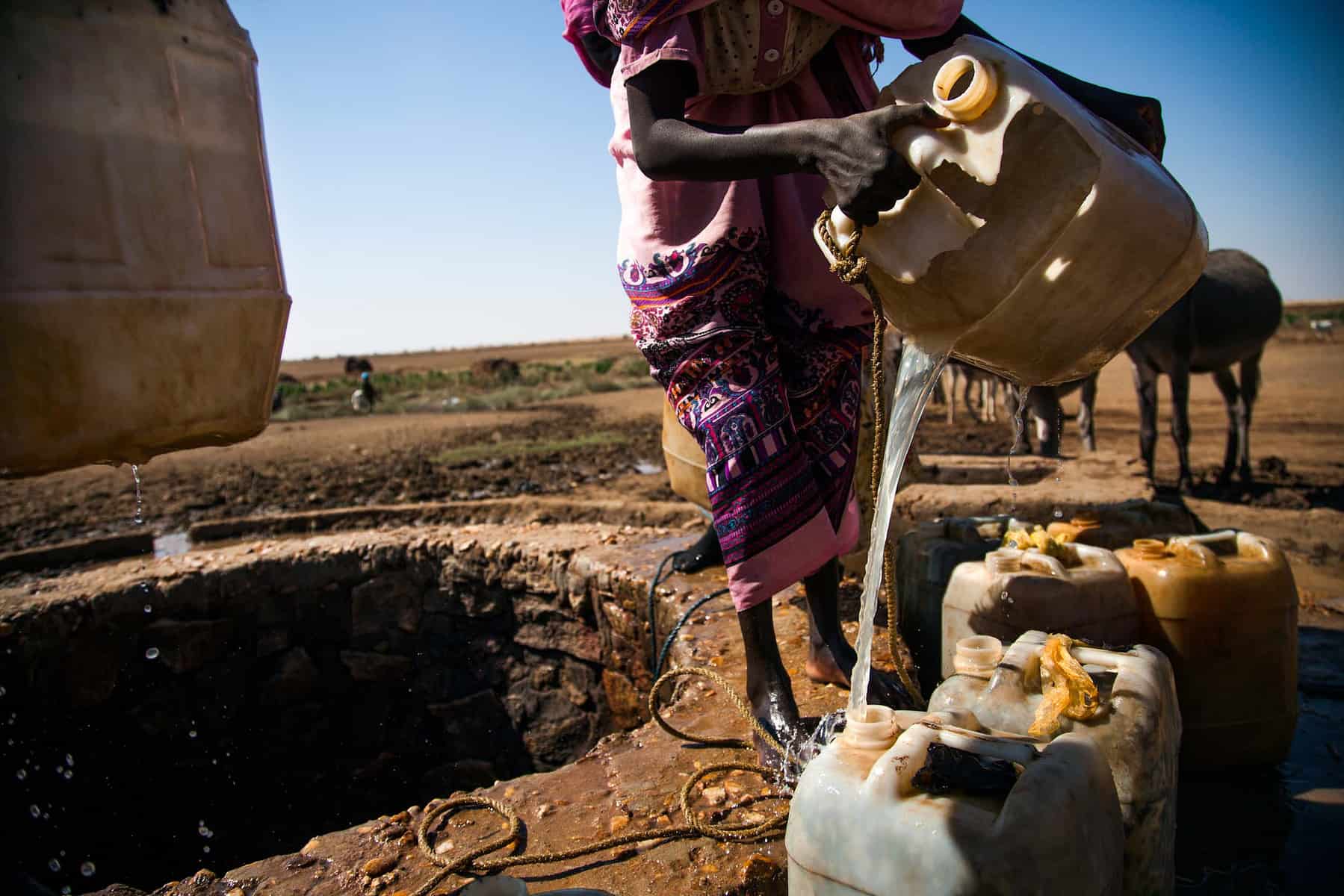
(cc) Albert Gonzlez Farran – UNAMID
Freshwater bodies such as rivers and aquifers supply the water that people and businesses rely on. But pressures on these bodies have been mounting worldwide during the last century. Population and economic growth have led to greater water use and increased pollution, with many basins around the world undergoing pervasive water shortages and quality degradation. Researchers expect the impacts of climate change to exacerbate these damages. At the same time, the global economy needs to continue growing to be able to adequately sustain the world’s rising population. However, the linkage between water and economic growth has increased global concerns about the impacts of water-related risks such as scarcity, droughts, floods, and pollution on economies’ ability to grow and create jobs. In fact, the World Economic Forum’s 2016 Global Risks Report ranks water as the highest global risk on economies over the next ten years.
When we talk about water and jobs, it is also important to mention that nearly 750 million people lack access to safe water and 2.5 billion live without adequate sanitation across the developing countries. People in these countries are constantly searching for water, which leaves limited time for productive work and skills building that yield better employment.
As we look towards the future, the link between water and employment becomes even more crucial. Water-related risks, which are expected to intensify due to climate change, will likely have adverse impacts on economy and employment, leading to major consequences beyond the water industry. For instance, researchers have linked the extreme drought in Syria between 2007 and 2010 to the uprising that began there in 2011. Several years of drought caused an extensive crop failure and massive losses of livestock, which resulted in 2 to 3 million people driven into unemployment and poverty. This situation contributed to a mass rural exodus into economically depressed cities, deepening existing instability in that country.
How do we avoid more crises like this? The complex and evolving water challenges of the future can only be addressed by investing in sustainable and integrated water management solutions such as those being identified and tested by the Water Futures and Solutions (WFaS) initiative at IIASA . WFaS is a cross-sector, collaborative, global initiative aimed at developing plausible scenarios of future water supply and demand, and identifying robust and no-regret portfolio of solutions for balancing water systems. The initiative brings together researchers and decision makers from governmental and non-governmental organizations as well as from the private industry and from a wide variety of sectors influencing water management. The potential water solutions include improved water policies and governance structures and the adoption of more innovative and environmentally friendly water technologies. Sustainable water resource management does not only address water-related risks, but it can also create green job opportunities for local and disadvantaged communities, for example in efficiency improvement works, in the production of alternative water sources, and in aquatic ecosystem restoration projects.
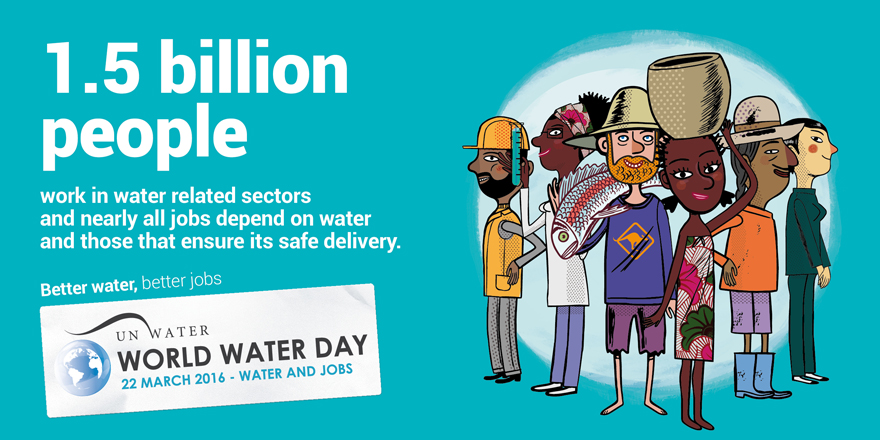
World Water Day © UN-Water
Note: This article gives the views of the author, and not the position of the Nexus blog, nor of the International Institute for Applied Systems Analysis.












You must be logged in to post a comment.